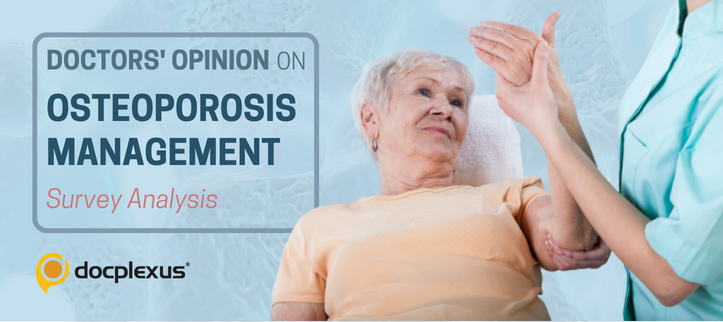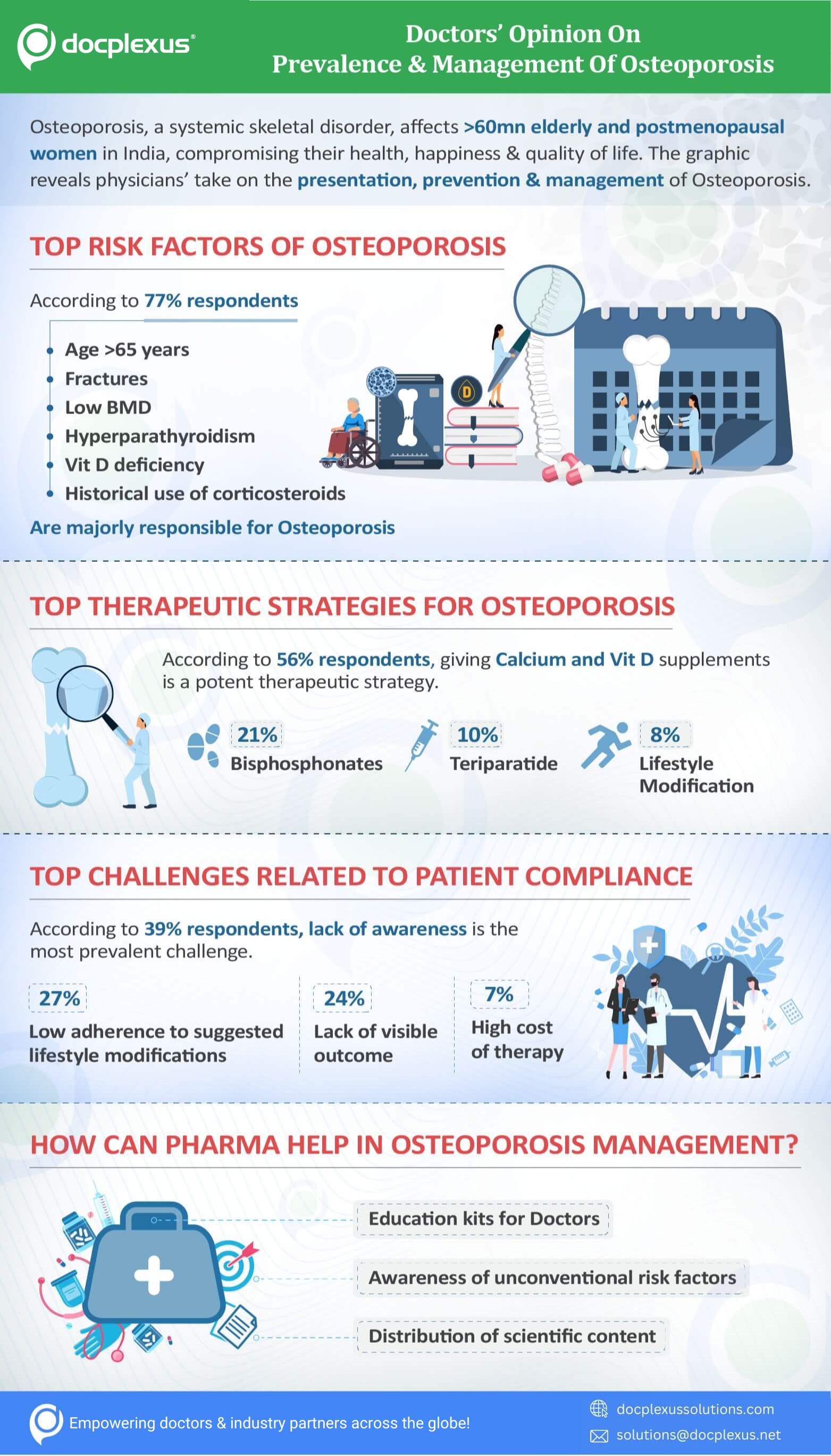
Osteoporosis is often called as ‘silent disease’ due to its asymptomatic nature until complicated by fractures. This debilitating disease has a severe impact on self-image, back pain, fractures, and mortality. Osteoporosis affects women 8X times more than males.
Global estimates suggest 200 million women suffer from the disease while around 61 million women in India are known to have osteoporosis. Post-menopause is often described in terms of physical and psychological changes such as anovulatory cycles, ovarian failure, disturbed sleep, vaginal dryness, fatigue, irritability, etc. But, post-menopausal women also suffer from illness and disability, usually attributed to osteoporosis.
Pharma companies have a window of opportunity to work in the area of raising awareness regarding the prevalence of postmenopausal osteoporosis (PMO), and its aftermath. The scope runs through nutritional therapy such as calcium and vitamin D supplementation, to pharmacological therapy such as Abaloparatide, Romosozumab, and the like.
In order to assess Doctors’ views on their experience with osteoporotic patients, postmenopausal women with osteoporosis, the target for therapy, and the current diagnostic and therapeutic treatment for osteoporosis, we conducted a survey among our community members.
Survey Details
Aim: To assess the awareness across physicians regarding the presentation, prevention, and management of osteoporosis
Methodology: A nationwide online poll on Docplexus platform
Respondents: 1,016 doctors including GPs, orthopedists, gynecologists, consulting physicians, orthopedic surgeons, internal medicine, family medicine practitioners, and radiologists.
 Survey Results Analysis
Survey Results Analysis
i) Fewer Cases Reported Despite a Higher Prevalence
Some governments and HCPs have recognized osteoporosis as a major public health problem. However, not much progress has been achieved in terms of public awareness required for successful prevention and management of the disease. This is validated by the results obtained in our survey. Despite the high prevalence of the disease in our country, only 18% of doctors reported seeing more than 20 new/unique cases of osteoporosis in a month while most of the doctors (40%) come across only 0-5 such cases in a month in their practice. 54% of doctors also reported often counseling both male and female osteoporotic patients >50 years while only 23% of doctors often counseled postmenopausal women. The results substantiate that the HCPs need to understand the level of knowledge or awareness regarding osteoporosis, especially among women.
ii) Better Awareness Leads To Better Patient Compliance
Patient compliance is critical to the successful management of a disease. 39% of doctors found a lack of awareness among patients as a major challenge related to patient compliance while 27% thought low adherence to recommended lifestyle modification to contribute to the challenges. Awareness or identification of a health problem by a patient is the first step that will lead to a physician’s visit. Also, better knowledge of chronic disease by patients is associated with better adherence to the medication.
iii) The Most Common Risk Factor For Osteoporosis According to HCPs
There are several risk factors associated with osteoporosis such as gender, skeletal size, decreased intake of calcium and physical inactivity, decreased estrogen levels, menopause, and early menopause. 77% of doctors who participated in the survey voted for age >65 years, presence of fractures, low BMD, hyperparathyroidism, vitamin D deficiency, and history of long-term use of corticosteroids as common risk factors for osteoporosis. However, vitamin D deficiency was considered the single most common risk factor by 11% of doctors.
In the same survey, about 56% of doctors primarily preferred calcium and vitamin D supplementation for osteoporosis therapy.
Calcium is required for bone mineral deposition while vitamin D helps in calcium absorption and new bone formation. Clinical research has demonstrated a positive influence of adequate calcium and vitamin D intake on bone mineral density.
iv) Moving Beyond Nutritional Therapy
With the increasing knowledge of bone biology and an understanding of the molecular mechanisms involved in bone formation and resorption, novel therapeutic targets have been identified. Recent advancements in anti-osteoporotic pharmacotherapeutics include denosumab, teriparatide, abaloparatide, and romosozumab.
A subsection of the population i.e., postmenopausal women, are vulnerable to primary hyperparathyroidism (PHP) that may also have adverse effects on the bones. Surprisingly, hyperparathyroidism, an established risk factor, was voted by none as the single-most considerable factor that causes osteoporosis. This proves how calcium and vitamin D deficiencies are identified and acted upon easily to treat osteoporosis, but hyperparathyroidism as a risk factor for osteoporosis is neglected.
According to our survey, the recently approved parathyroid hormone-related peptide analog (Abaloparatide) caught the attention of around 60% of doctors. Abaloparatide is shown to increase bone mineral density and reduce fractures in postmenopausal osteoporotic patients over 18 months.
How Can Pharma Bridge The Gap In The Management Of Osteoporosis?
Educating doctors and counseling patients may form the first step towards better management of osteoporosis, especially PMO. Pharma companies can use various mediums for doctors, a wide section of the population responsible for reducing the burden on healthcare and educating the patients. Therefore, HCPs may be targeted in an appropriate way to achieve the desired outcome.
i) Education kits for doctors and patients, respectively
Just as how our survey could have been an eye-opener for several physicians, informative education material on disease prevalence, risk factors, symptoms, prescribing instructions, and checklists may be of interest and help to the HCPs.
Similar educational kits for patients that include basic information of the disease, symptoms, self-management methods, and physician visit schedules may be of help.
ii) Keeping an eye on the conventional and the unconventional target areas
A disease may have various risk factors that may be conventional or unconventional. In the case of osteoporosis, the established ones are calcium and vitamin D deficiency which have tried-and-tested therapeutic options available already. However, pharma companies can exert leverage by focusing on the lack of awareness regarding unconventional areas such as post-menopause and PHP, and provide solutions that will help them to reach out to more doctors and patients.
iii) An effective and reliable method of communication
Doctors need consistent and reliable pieces of information while prescribing a drug to their patients. Hence, pharma companies must effectively communicate the efficacy, safety, and toxicity of their drug to the doctors with supporting clinical data to ensure a better quality of life for patients and visible outcomes of the therapy.
iv) Distribution of up-to-date content based on the latest clinical research
Pharma companies can secure credibility among doctors by providing content that is well-researched and based on recently obtained clinical data. The latest research contributes to the relevance of the data provided; this is beneficial for doctors.
Docplexus – Pharma’s Trusted Marketing Partner
Docplexus is one of the world’s largest & fastest-growing networks of verified doctors & a trusted marketing partner of pharma, medical devices, diagnostics & nutraceutical companies. We empower our industry partners to meaningfully engage with the medical community through data-driven, evidence-based marketing & brand management solutions such as infocenter (branded microsite), mindset analysis, KOL webinars, sponsored medical updates, online CMEs & more.
You can reach us at: solutions@docplexus.net
